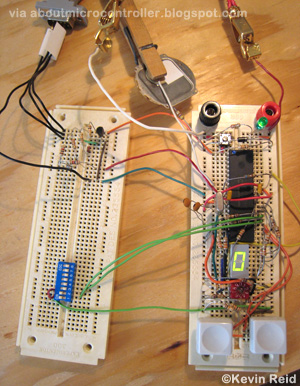Magnetic Levitation SYSTEM IDENTIFICATION
A fundamental concept in science and technology is that of mathematical
modeling. System identification is conducted to obtain the plant transfer function
needed for the control design. Once a good model is obtained and verified, a
suitable control law can be implemented to compensate the plant instability and
improve performance.
Analytical Model
Analytical and experimental plant models were obtained for comparison
and verification. According to T. H. Wong, laboratory-scale maglev systems are
represented with electrical and mechanical equations [1]. Figure 3 shows the RLC
coil circuit that displaces the steel ball using electromagnetism.
more
Determination of the Levitation System Model
The force/current/displacement relationship in the considered equipment given in Fig. 5
is extremely difficult to determine using an analytic method. Moreover, the obtained approximate
analytical expression f(x, i) is very complex for the further experimental purpose
[3]. However, the magnetic force characteristics may be experimentally calibrated as
a function of the applied current I and the ball position X. Namely, the experiment could
be consisted of resting the levitation metallic sphere on a non-magnetic stand directly
under the electromagnet. This special kind of xyz-stage (some solutions are shown in
Fig.8(a)-(c)) should be capable, for example, of 1mm incremental positioning and determining
the minimum current required to pick up the ball at various heights. Then the
model of the force/distance relationship can be determined by means of least squares fitting.
Note, that the validity of such obtained curve is limited to some range
Xmin ≤ X ≤ Xmax. At the moment, in the Laboratory of Automatic Control at the Faculty of
Electronic Engineering in Niš, the problem of the remote placement of the steel sphere
among the vertical axis of the electromagnet is still not realized adequately. Hence, this is
one of the basic problems in remote control of MagLev system in the underdeveloped
web-based laboratory at the Faculty, which was established in order to support learning in
automatic control. For now, as shown in Fig. 8, it is expected that the ball be placed along
the electromagnet vertical axis by the laboratory technician.
more
Magnetic Levitation System
General Description
The process consists of a disk whose position can be controlled by a top and a bottom coil. Depending on which coil is used, this system can be either open loop stable (using the bottom coil) or unstable (using the top coil). Disk position is measured by laser sensors. The coil voltage is limited to [0, 3] V .
Initial tests perform system identification to quantify
the plant parameters and measure the strong
nonlinearities. Early experiments demonstrate application
of simple linear closed loop control to stabilize
and regulate the closed loop system about some
setpoint. It is shown that for the open loop stable
plant, (see front page) the system is stabilizable for all
positive gains but that for the unstable plant a minimum
gain (bandwidth) is necessary for closed loop
stability. Further tests vividly show the effect of the
nonlinear dynamics on closed loop tracking control
(see upper plots). By inverting these dynamics, rapid
and precise tracking control is demonstrated.
more
Design and Implementation of a Controller for a
Magnetic Levitation System
System Analysis and Design
1. Dynamic Model Analysis
The magnetic levitation system in this paper is
illustrated in Figure 1a; it keeps a steel ball suspended
in the air by counteracting the ball’s weight with
electromagnetic force. x(t) is the distance between the
steel ball and the electromagnet. X0, the reference
position, is the proper levitation distance. The electromagnetic
force, f(x,t), acts on the ball, which can
be expressed as the following dynamic formula in an
upward direction according to Newton’s law.
Control system block diagram of the magnetic levitation
system.
more
Design of Magnetic Levitation Controllers Using Jacobi Linearization, Feedback Linearization and Sliding Mode Control
THE goal of this project was to design three (one linear;two nonlinear) magnetic levitation controllers for the system shown in Fig. 1. Despite the fact that magnetic levitation systems are described by nonlinear differential equations [2], a simple approach would be to design a controller based on the linearized model (Jacobi linearization about a nominal operating point [6]). But this means the tracking performance deteriorates rapidly with increasing deviations from the nominal operating point. Nevertheless, a controller based on Jacobi linearization is a good ”litmus test” for our system identification, hence this controller is designed first.
II. SYSTEM IDENTIFICATION (BART AND KEVIN)
A. Physical Description of the System Components (KEVIN)
In Fig. 1, the different components are:
_ HV oltage to Current Inverter: This subsystem converts the output voltage from our controller into input current for the electromagnet .The reason for using this system is to separate the power amplifier (for a high current sink like the electromagnet) from the controller.
_ HSensor Electronics: For our Jacobi Linearization based controller, we use a simple red LED and a photoresistor. The reason for this is we emperically found that we need large gain values for the Hall Effect sensor solution. But for our nonlinear controllers, in order to sense a wider range of motion for the ball, we obtained data from two Melexis [4] Hall Effect sensors s1 and s2. We need two sensors instead of one because we emperically determined that the reading from a single sensor is
saturated by the magnetic field of the electromagnet. We are able to subtract the readings of the two sensors to get a nonlinear voltage function for the position of the ball.
_ Electromagnet: This is our plant, the model is derived below.
_ Controller: Designing this subsystem was the goal of this project. Again, as stated earlier, we were only able to design and implement the Jacobi linearization version.
more
Buy Cheap Magnetic Levitation Toy






















